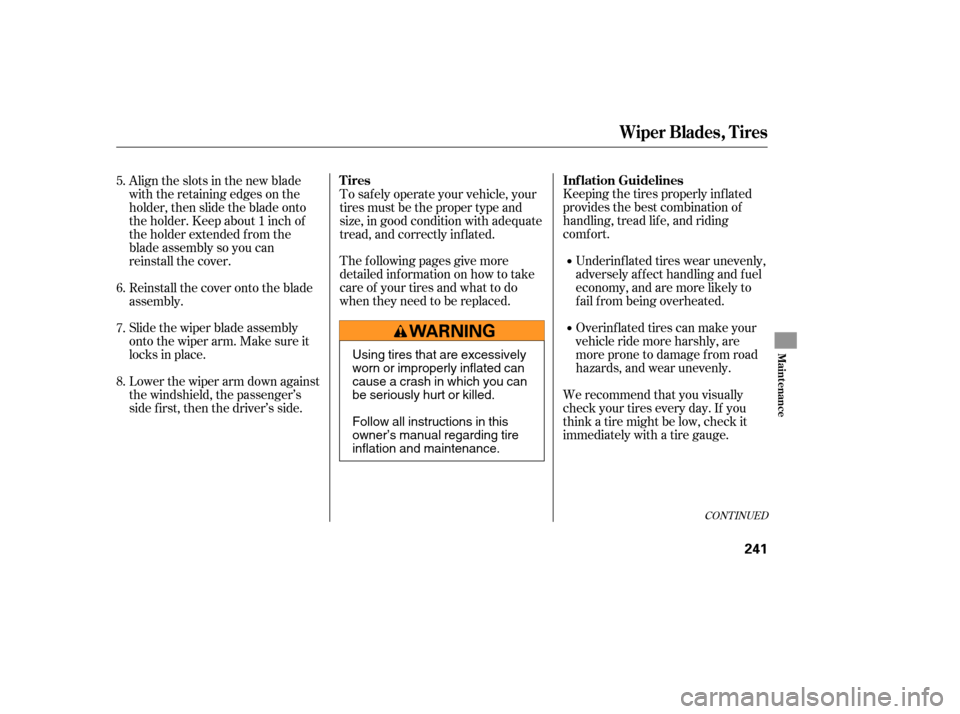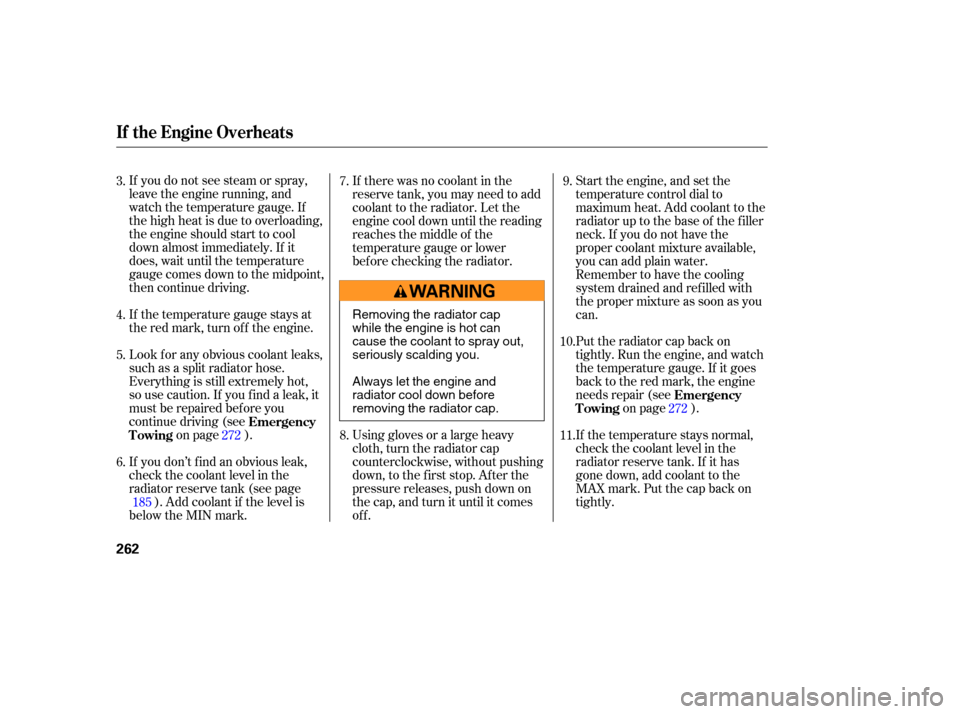Page 240 of 307
Open the trunk.Pull the bulb straight out of its
socket. Push the new bulb straight
into the socket until it bottoms.
Remove the screw in the center of
the fastener on the side of the
trunk lining. Pull the lining back. Reinstall the socket into the light
assembly by turning it clockwise
until it locks.
Turn on the lights to make sure
the new bulb is working.
Reinstall the trunk lining. Make
sure it is installed under the edge
of the trunk seal.
Put the f astener into the hole on
the side of the trunk lining.
Reinstall the screw.
Determine which of the f our bulbs
is burned out: stop/taillight, back-
up light, side marker light, or turn
signal light.
Remove the socket by turning it
one-quarter turn counterclockwise.
1. 2.
3.4.
5.
6.
7.
8.
Replacing Rear Bulbs
Lights
236
FASTENER
�����—�����—�����y�
����
����
�
�y���
�(�+���������y���������y
Page 241 of 307
If your seat belts get dirty, use a sof t
brush with a mixture of mild soap
and warm water to clean them. Do
not use bleach, dye, or cleaning
solvents. Let the belts air-dry bef ore
you use the vehicle.
Reinstall the cover, and tighten its
holding clips securely. Reinstall the socket. Turn it
clockwise until it locks. Make sure
the new bulb is working. Pull the bulb straight out of its
socket. Push the new bulb straight
into the socket until it bottoms.
Open the trunk, then remove the
holding clips f rom the cover, and
remove the cover.
Remove the socket f rom the light
assembly by turning it one-quarter
turn counterclockwise.
2. 1.
3.
4.
5.
CONT INUED
On DX and LX models
Replacing a High-mount Brake
Light Bulb Cleaning the Seat Belts
Lights, Cleaning the Seat Belts
Maint enance
237
SOCKETBULB LOOP
�����—�����—�����y�
����
��������y���
�(�+���������y���������y
Page 245 of 307

Keeping the tires properly inf lated
provides the best combination of
handling, tread lif e, and riding
comf ort.Underinf lated tires wear unevenly,
adversely affect handling and fuel
economy, and are more likely to
fail from being overheated.
Overinf lated tires can make your
vehicleridemoreharshly,are
more prone to damage f rom road
hazards, and wear unevenly.
We recommend that you visually
check your tires every day. If you
think a tire might be low, check it
immediately with a tire gauge.
To saf ely operate your vehicle, your
tires must be the proper type and
size, in good condition with adequate
tread, and correctly inf lated.
The f ollowing pages give more
detailed inf ormation on how to take
care of your tires and what to do
when they need to be replaced.
Align the slots in the new blade
with the retaining edges on the
holder, then slide the blade onto
the holder. Keep about 1 inch of
the holder extended f rom the
blade assembly so you can
reinstall the cover.
Reinstall the cover onto the blade
assembly.
Slide the wiper blade assembly
onto the wiper arm. Make sure it
locks in place.
Lower the wiper arm down against
the windshield, the passenger’s
side first, then the driver’s side.
5.
6.
7.
8.
CONT INUED
Inf lation Guidelines
Tires
Wiper Blades, Tires
Maint enance
241
Using tires that are excessively
worn or improperly inflated can
cause a crash in which you can
be seriously hurt or killed.
Follow all instructions in this
owner’s manual regarding tire
inflation and maintenance.
�����—�����—�����y�
����
�
������y���
�(�+���������y���������y
Page 254 of 307

If you need to park your vehicle f or
an extended period (more than 1
month), there are several things you
should do to prepare it f or storage.
Proper preparation helps prevent
deterioration and makes it easier to
get your vehicle back on the road. If
possible, store your vehicle indoors.Fill the f uel tank.
Change the engine oil and f ilter. Block the rear wheels.
If the vehicle is to be stored f or a
longer period, it should be
supported on jackstands so the
tires are of f the ground.
Wash and dry the exterior
completely.
Cleantheinterior.Makesurethe
carpeting, floor mats, etc., are
completely dry. Cover the vehicle with a
‘‘breathable’’ cover, one made
f rom a porous material such as
cotton. Non-porous materials, such
as plastic sheeting, trap moisture,
which can damage the paint.
Leave one window open slightly (if
the vehicle is being stored
indoors). If possible, periodically run the
engine until it reaches f ull
operating temperature (the
cooling f ans cycle on and of f
twice). Pref erably, do this once a
month.
To minimize sticking, apply a
silicone spray lubricant to all door
and trunk seals. Also, apply a
vehiclebodywaxtothepainted
surfaces that mate with the door
and trunk seals. Support the f ront wiper blade
arms with a f olded towel or rag so
they do not touch the windshield. Disconnect the battery.
Leave the parking brake off. Put
the transmission in reverse
(manual) or Park (automatic).
Vehicle Storage
250
�����—�����—�����y�
����
��������y���
�(�+���������y���������y
Page 257 of 307

CONT INUED
If you have a f lat tire while driving,
stop in a saf e place to change it.
Drive slowly along the shoulder until
you get to an exit or an area that is
far away from the traffic lanes.
Thesizedifferencemayalsocause
damage to the dif f erential, so do not
mount the compact spare on the
f ront. If either f ront tire goes f lat,
removethereartireonthatsame
side, mount the compact spare tire
on the rear, then mount the rear tire
on the f ront.Turn on the hazard warning lights,
and turn the ignition switch to the
LOCK (0) position. Have all
passengers get out of the vehicle
while you change the tire. Park the vehicle on f irm, level, and
non-slippery ground. Put the
transmission in Park (automatic)
or reverse (manual). Apply the
parking brake.Open the trunk. Raise the trunk
f loor by lif ting up on the back edge.
Unscrew the wing bolt, and take
the spare tire out of its well. Take the tool kit case out of the
trunk.
Thecompactsparetireissmaller
than a standard tire, and it will affect
the vehicle’s handling. Drive
cautiously when the spare is
mounted on your vehicle.
5. 4.
3.
2. 1.
On Si model only
Changing a Flat Tire
T aking Care of t he Unexpect ed
253
SPARE TIRE
TRUNK FLOOR JACK TOOL CASE
The vehicle can easily roll off
the jack, seriously injuring
anyone underneath.
Follow the directions for
changing a tire exactly, and
never get under the vehicle
when it is supported only by the
jack.
�����—�����—�����y�
����
����
���y���
�(�+���������y���������y
Page 258 of 307
Loosen each wheel nut 1/2 turn
with the wheel nut wrench.Place the jack under the jacking
point nearest the tire you need to
change. Turn the end bracket
clockwise until the top of the jack
contacts the jacking point. Make
sure the jacking point tab is
restinginthejacknotch.Use the extension and the wheel
nut wrench as shown to raise the
vehicle until the f lat tire is of f the
ground.
Remove the wheel nuts, then
remove the f lat tire. Handle the
wheel nuts caref ully; they may be
hot from driving. Place the flat tire
on the ground with the outside
surface facing up.
6. 7. 8.
9.
Changing a Flat Tire
254
WHEEL NUT WRENCHJACKING POINTS
EXTENSION
WHEEL NUT WRENCH
�����—�����—�����y�
����
��������y���
�(�+���������y���������y
Page 261 of 307

When you turn the ignition switch to
the START (III) position, you do not
hear the normal noise of the engine
trying to start. You may hear a
clicking sound or series of clicks, or
nothing at all.
Check these things:Check the transmission interlock.
If you have a manual transmission,
the clutch pedal must be pushed
all the way to the f loor or the
starter will not operate. With an
automatic transmission, it must be
in Park or neutral.
Diagnosing why the engine won’t
start f alls into two areas, depending
on what you hear when you turn the
ignition switch to the START (III)
position:
You hear nothing, or almost
nothing. The engine’s starter
motor does not operate at all, or
operates very slowly.
You can hear the starter motor
operating normally, or the starter
motor sounds like it is spinning
f aster than normal, but the engine
does not start up and run.
Store the jack and tools in the tool
kit case. Place the tool kit case in
the center of the flat tire.
Store the wheel cover or center
cap in the trunk. Make sure it does
not get scratched or damaged.
Lower the trunk f loor, then close
the trunk lid.
Turn the ignition switch to the ON
(II) position. Turn on the
headlights, and check their
brightness. If the headlights are
very dim or do not come on at all,
the battery is discharged. See
on page .259
18.
19.
20.
CONT INUED
Nothing Happens or the Starter
Motor Operates Very Slowly
If the Engine Won’t Start
Jump Starting
Changing a Flat Tire, If the Engine Won’t Start
T aking Care of t he Unexpect ed
257
Loose items can fly around the
interior in a crash and could
seriously injure the occupants.
Store the wheel, jack, and tools
securely before driving.
�����—�����—�����y�
����
��������y���
�(�+���������y���������y
Page 266 of 307

Put the radiator cap back on
tightly. Run the engine, and watch
the temperature gauge. If it goes
back to the red mark, the engine
needs repair (seeon page ).
If you do not see steam or spray,
leave the engine running, and
watch the temperature gauge. If
the high heat is due to overloading,
the engine should start to cool
down almost immediately. If it
does, wait until the temperature
gauge comes down to the midpoint,
then continue driving.
If the temperature gauge stays at
the red mark, turn of f the engine.
Look f or any obvious coolant leaks,
such as a split radiator hose.
Everything is still extremely hot,
so use caution. If you f ind a leak, it
must be repaired bef ore you
continue driving (see
on page ).
If you don’t f ind an obvious leak,
check the coolant level in the
radiator reserve tank (see page ). Add coolant if the level is
below the MIN mark. Start the engine, and set the
temperature control dial to
maximum heat. Add coolant to the
radiator up to the base of the f iller
neck. If you do not have the
proper coolant mixture available,
you can add plain water.
Remember to have the cooling
system drained and ref illed with
the proper mixture as soon as you
can.
If the temperature stays normal,
check the coolant level in the
radiator reserve tank. If it has
gone down, add coolant to the
MAX mark. Put the cap back on
tightly.
Using gloves or a large heavy
cloth, turn the radiator cap
counterclockwise, without pushing
down, to the f irst stop. Af ter the
pressure releases, push down on
the cap, and turn it until it comes
off. If there was no coolant in the
reserve tank, you may need to add
coolant to the radiator. Let the
engine cool down until the reading
reaches the middle of the
temperature gauge or lower
bef ore checking the radiator.
7.
8. 9.
3.
4.
5.
6. 272
185 272
10.
11.
Emergency
Towing
Emergency
Towing
If theEngineOverheats
262
Removing the radiator cap
while the engine is hot can
cause the coolant to spray out,
seriously scalding you.
Always let the engine and
radiator cool down before
removing the radiator cap.
�����—�����—�����y�
����
��������y���
�(�+���������y���������y